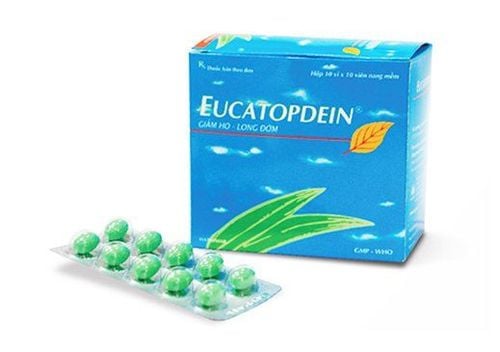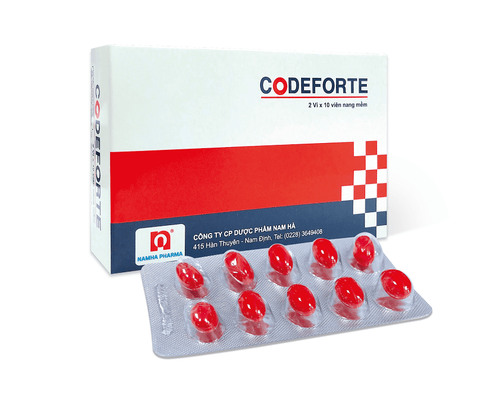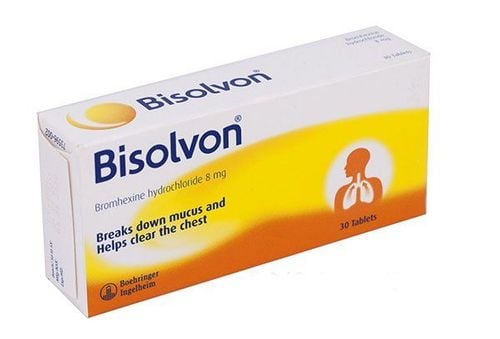This is an automatically translated article.
One of the symptoms caused by Covid-19 is cough, phlegm. To treat this symptom, there is a drug preparation Haterpin containing the main active ingredient, Terpin hydrate, which supports the treatment of cough and expectoration.
1. What is Haterpin?
Haterpin is a sugar coated tablet containing the main active ingredients Terpin hydrate 50mg and Sodium benzoate 100mg. Terpin hydrate is an expectorant, commonly used to loosen mucus and relieve congestion by the main reflex mechanism, the cough reflex, to clear them in patients with acute or chronic bronchitis. and related lung conditions.Terpin hydrate is derived from sources such as turpentine, oregano, thyme and eucalyptus. It was common in the United States in the late nineteenth century, but was removed from marketed drugs in the 1990s after the FDA stated that "based on available evidence, there are insufficient data to establish establish general recognition of the safety and effectiveness of these ingredients".
Haterpin is sold to patients as a prescription drug.
Pharmacodynamics:
Terpin hydrate has the effect of facilitating the removal of mucus from the respiratory tract. Prevents the overproduction and secretion of mucus due to bacterial or viral infections of the airways, asthma or chronic bronchitis. Terpin hydrate changes the consistency of mucus and makes coughing worse. About the pharmacokinetics:
The pharmacokinetics of the drug Haterpin includes the process of drug when it is introduced until it is eliminated.
Ability to absorb: after taking the drug Haterpin is rapidly absorbed mainly from the gastrointestinal tract. Bioavailability is relatively high (85%). When used with food and water containing sugar, the rate of drug absorption decreases gradually. Distribution: The volume of distribution of Haterpine is quite small. Metabolism: into pharmacologically active form. Elimination: The drug is filtered by the glomeruli, excreted in the renal tubules and excreted in the urine. According to statistics, 97% of a dose of sodium benzoate is excreted in the urine in the form of hippuric acid. The mean half-life is 8 hours, depending on the patient.
2. What does Haterpin do?
Use of Haterpin is to relieve cough and expectorant is indicated in the following cases: Acute and chronic bronchitis, pneumonia, bronchiectasis, chronic obstructive pulmonary disease, infectious and inflammatory diseases upper respiratory tract.Haterpin is contraindicated in the following cases:
Hypersensitivity. Pregnant. Breastfeeding women. Patients with asthma, severe bronchial asthma, COPD. Children < 30 months old, history of febrile convulsions, epilepsy.
3. Dosage and usage of the drug Haterpin
3.1. Dosage Adults: 1-2 tablets x 2-3 times/day. Children > 30 months old: 1 tablet/day, divided equally 1-2 times/day. Note: Haterpin is a prescription drug, so the dose depends on the doctor treating the condition, age and immunity to be able to adjust the dose to suit each patient. 3.2. How to take Haterpin is taken orally. Patients should drink with about 200ml of water, which can be dangerous for users if drinking too little water.
For best results, take Haterpin 1 to 2 hours after a meal. Because the sugar in food and drink reduces the effectiveness of the medicine.
4. Side effects of the drug Haterpin
Digestive disorders: nausea, vomiting, constipation. Dizzy . Feeling sleepy, somnolent. Disorders of coordination, depression. Allergic reactions: skin, face swelling, throat swelling... People need to stop using the drug when experiencing allergic reactions and go to the nearest medical facility for examination and timely treatment.
5. Possible drug interactions when combining Haterpin with other drugs
When combined with atropin, patients may experience hyperkalemia, functional diseases. The inhibitory effect of angiotensin 2 leads to hypoaldosteronism and consequent potassium retention. It is recommended to avoid the combination of these 2 drugs because it can cause cardiac conduction disturbances, especially in people with severe renal failure, heart failure, the elderly and children. Morphine, CNS depressants increase the respiratory depressive effect. Antidepressants: fluoxetine, amitriptyline... will increase the effect of depression. Sedatives: diazepam... Drug interactions occur that can have serious consequences. Therefore, it is necessary to avoid drug interactions to have the best treatment effect for the patient and limit side effects.
6. How to handle missed dose or overdose case
6.1. When you miss a dose Take it as soon as you remember that you have missed a dose. If it is almost time for your next dose, skip the missed dose and continue taking the next dose as directed. Never make up for a double missed dose. 6.2. When overdosed, the patient may experience some signs such as: lethargy, lethargy, respiratory failure, coma, cold and moist skin, rapid drop in body temperature, slow pulse, low blood pressure. At that time, the patient should be taken to the hospital for timely treatment measures such as:
Restore respiratory capacity by providing oxygen and controlled respiration with supportive means to recover respiratory capacity. In severe cases, detoxification with intravenous naloxone.
Please dial HOTLINE for more information or register for an appointment HERE. Download MyVinmec app to make appointments faster and to manage your bookings easily.













